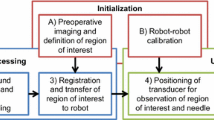Abstract
We present a novel semi-autonomous clinician-in-the-loop strategy to perform the laparoscopic cryoablation of small kidney tumors. To this end, we introduce a model-independent bimanual tissue manipulation technique. In this method, instead of controlling the robot, which inserts and steers the needle in the deformable tissue (DT), the cryoprobe is introduced to the tissue after accurate manipulation of a target point on the DT to the desired predefined insertion location of the probe. This technique can potentially reduce the risk of kidney fracture, which occurs due to the incorrect insertion of the probe within the kidney. The main challenge of this technique, however, is the unknown deformation behavior of the tissue during its manipulation. To tackle this issue, we proposed a novel real-time deformation estimation method and a vision-based optimization framework, which do not require prior knowledge about the tissue deformation and the intrinsic/extrinsic parameters of the vision system. To evaluate the performance of the proposed method using the da Vinci Research Kit, we performed experiments on a deformable phantom and an ex vivo lamb kidney and evaluated our method using novel manipulability measures. Experiments demonstrated successful real-time estimation of the deformation behavior of these DTs while manipulating them to the desired insertion location(s).





Similar content being viewed by others
References
Azar, F. S., D. N. Metaxas, and M. D. Schnall. Methods for modeling and predicting mechanical deformations of the breast under external perturbations. Med. Image Anal. 6:1–27, 2002.
Baker, S., and I. Mathews. Lucas-Kanade Years On: A Unifying Framework: Part 1, 2 & 3. Pittsburgh: Robotics Institute, Carnegie Mellon University, 2004.
Bradski, G., and A. Kaehler. Learning OpenCV: Computer Vision with the OpenCV Library. Sebastopol: O’Reilly Media, Inc., 2008.
Broyden, C. G. A class of methods for solving nonlinear simultaneous equations. Math. Comput. 19:577–593, 1965.
Cestari, A., G. Guazzoni, V. Dell’acqua, L. Nava, G. Cardone, G. Balconi, R. Naspro, F. Montorsi, and P. Rigatti. Laparoscopic cryoablation of solid renal masses: intermediate term followup. J. Urol. 172:1267–1270, 2004.
Chen A. I., M. L. Balter, T. J. Maguire and M. L. Yarmush. Real-time needle steering in response to rolling vein deformation by a 9-DOF image-guided autonomous venipuncture robot. In: Intelligent Robots and Systems (IROS), 2015 IEEE/RSJ International Conference on, IEEE, pp. 2633–2638, 2015.
Fadda M., D. Bertelli, S. Martelli, M. Marcacci, P. Dario, C. Paggetti, D. Caramella and D. Trippi. Computer assisted planning for total knee arthroplasty. In: CVRMed-MRCAS’97. Springer, pp. 617–628, 1997.
Finley, D. S., S. Beck, G. Box, W. Chu, L. Deane, D. J. Vajgrt, E. M. McDougall, and R. V. Clayman. Percutaneous and laparoscopic cryoablation of small renal masses. J. Urol. 180:492–498, 2008.
Gill, P. E., W. Murray, and M. H. Wright. Practical Optimization. London: Academic Press, 1981.
Glauser, D., H. Fankhauser, M. Epitaux, J.-L. Hefti, and A. Jaccottet. Neurosurgical robot Minerva: first results and current developments. J. Image Guid. Surg. 1:266–272, 1995.
Goksel, O., E. Dehghan, and S. E. Salcudean. Modeling and simulation of flexible needles. Med. Eng. Phys. 31:1069–1078, 2009.
Kazanzides P., Z. Chen, A. Deguet, G. S. Fischer, R. H. Taylor and S. P. DiMaio. An open-source research kit for the da Vinci® Surgical System. In: Robotics and Automation (ICRA), 2014 IEEE International Conference on. IEEE, pp. 6434–6439, 2014.
Khadem, M., C. Rossa, R. S. Sloboda, N. Usmani, and M. Tavakoli. Ultrasound-guided model predictive control of needle steering in biological tissue. J. Med. Robot. Res. 1:1640007, 2016.
Khadem, M., C. Rossa, N. Usmani, R. S. Sloboda, and M. Tavakoli. Semi-automated needle steering in biological tissue using an ultrasound-based deflection predictor. Ann. Biomed. Eng. 45:924–938, 2017.
Misra, S., K. B. Reed, B. W. Schafer, K. Ramesh, and A. M. Okamura. Mechanics of flexible needles robotically steered through soft tissue. Int. J. Robot. Res. 29:1640–1660, 2010.
Moustris, G., S. Hiridis, K. Deliparaschos, and K. Konstantinidis. Evolution of autonomous and semi-autonomous robotic surgical systems: a review of the literature. Int. J. Med. Robot. Comput. Assist. Surg. 7:375–392, 2011.
Quigley M., K. Conley, B. Gerkey, J. Faust, T. Foote, J. Leibs, R. Wheeler, and A. Y. Ng. ROS: an open-source Robot Operating System. In: ICRA workshop on open source software, Kobe, p. 5, 2009.
Shademan, A., R. S. Decker, J. D. Opfermann, S. Leonard, A. Krieger, and P. C. Kim. Supervised autonomous robotic soft tissue surgery. Sci. Transl. Med. 8:337ra364–337ra364, 2016.
Webster, III, R. J., J. S. Kim, N. J. Cowan, G. S. Chirikjian, and A. M. Okamura. Nonholonomic modeling of needle steering. Int. J. Robot. Res. 25:509–525, 2006.
Wright, S. J., and J. Nocedal. Numerical optimization. Springer Sci 35:7, 1999.
Yoshikawa, T. Manipulability of robotic mechanisms. Int. J. Robot. Res. 4:3–9, 1985.
Acknowledgments
This work is supported in part by the NIH/NIBIB Grant R01EB016703, by the HK RGC under Grants 415011, by the HK ITF under Grants ITS/112/15FP and ITT/012/15GP, by the project #BME-8115053 of the Shun Hing Institute of Advanced Engineering, CUHK, and by the project 4930745 of the CUHK T Stone Robotics Institute, CUHK.
Author information
Authors and Affiliations
Corresponding author
Additional information
Associate Editor Robert Merrifield oversaw the review of this article.
Electronic supplementary material
Below is the link to the electronic supplementary material.
Supplementary material 1 (MP4 10947 kb)
Rights and permissions
About this article
Cite this article
Alambeigi, F., Wang, Z., Liu, Yh. et al. Toward Semi-autonomous Cryoablation of Kidney Tumors via Model-Independent Deformable Tissue Manipulation Technique. Ann Biomed Eng 46, 1650–1662 (2018). https://doi.org/10.1007/s10439-018-2074-y
Received:
Accepted:
Published:
Issue Date:
DOI: https://doi.org/10.1007/s10439-018-2074-y




